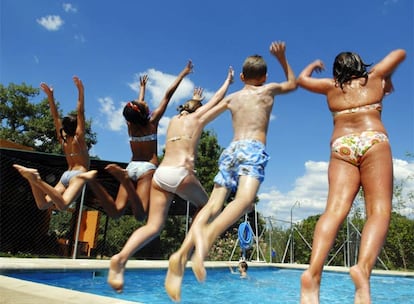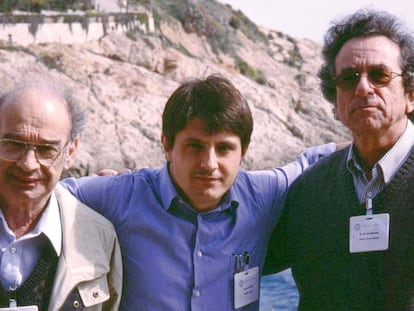Is it dangerous to swim after eating?
There is no scientific evidence to support the commonly held belief, and experts say the preventive focus should be on abrupt temperature changes

Every summer, in the hours that coincide with mealtimes, there are children at the beach or by the side of the pool, patiently waiting for the digestive process to run its course. When it has, they can finally get into the water: in what timeframe – between 30 minutes and two hours – depends on both the progenitor and the copiousness of the meal. What happens if they dive in prematurely? The name of the particular threat they face is commonly known as digestive failure. If the digestion process is cut short, according to popular belief, you could drown.
The idea that people should wait for a while after eating before swimming is commonplace in many countries, but popular explanations as to why differ from the possibility of digestive failure. Some experts warn it is more likely you will suffer from cramp, which could be dangerous when in the water. Others argue that, as practically all of a person’s blood is dedicated to the digestive process, less reaches the muscles in the arms and legs, making it more difficult to swim.
In reality, there is no scientific evidence to back any of these theories. As such, according to a 2011 analysis of the scientific literature available on the subject published in the International Journal of Aquatic Research and Education, “no reported cases of eating before swimming causing or contributing to fatal or non-fatal drowning are reported in any of the literature searched.” The scientific foundation of the study goes on to say that “eating before swimming is not a contributing risk for drowning and can be dismissed as a myth.” However, people still pay heed to the advice.
“It’s a bit of an urban myth to call it that [digestive failure], because it has little to do with digestion,” says Jesús Sueiro, spokesman for the Galician Association of Family and Community Medicine. “It has more to with thermal shock: going into cold water very abruptly. It is a circulatory collapse, it produces hypotension or a drop in blood pressure, a type of syncope. It can lead to dizziness and even vomiting and, if at the moment you are in the water, it can result in drowning due to a loss of consciousness.” Entering the water carefully, in a slow and progressive manner, allows the body to acclimatize and lessens the risk.
Food and exercise
Linking everything to meals, however, is not entirely unfounded. Andrés Sánchez Yagüe, head of the communication department at the Spanish Digestive System Foundation and head of services at the endoscopy unit of Marbella’s Hospital QuironSalud, explains that to some extent, the digestive process is cut off. “What we commonly refer to as digestive failure is known medically as hydrocution [or cold shock response]. What happens with this phenomenon is that, when faced with a sudden change of temperature, via skin contact with cold water, digestion is halted to divert blood flow from the digestive tract to the skin. So yes, when we refer to digestive failure, the process of digestion has been stopped.” The danger, says Yagüe, is when “the digestive symptoms include vomiting, which with a full stomach can trigger the passage of stomach contents to the lungs, facilitating drowning.”
Alberto García Sanz, director of the Spanish School of Lifesaving and Lifeguarding (RFESS), says that his organization makes the distinction between two different phenomena: in the view of the RFESS, digestive failure is in reality bad digestion. “When we have eaten, the digestive system needs a greater concentration of blood and oxygen, which can produce drowsiness because the brain has a shorter supply. If we are undertaking physical activity, what we are doing is causing the muscle groups involved in that activity to also require blood and oxygen, and that will increase the respiratory and cardiovascular rate. To the detriment of what? Digestive activity,” he explains. In this scenario, however, water is not the culprit: any form of physical activity on a full stomach can provoke gastrointestinal problems, nausea, vomiting and dizziness. If that happens when we are running it’s not a major problem. If we are swimming, it can cause us to drown.
On the other hand, García Sanz also highlights cold shock response. “If we dive suddenly into cold water, without showering first, at the moment of contact with the water there is a change in temperature, a thermo-differential shock. That can cause of a loss of consciousness and lead to drowning, even without eating,” he notes.
The term hydrocution was coined in the 1950s by French scientist G. Lartigue, as an analog to electrocution. It is an execution by water, but there is no scientific consensus on the specific physiological process that leads to syncope occurring, although everything points to a sudden change of temperature as the culprit as opposed to digestive functions.
Prevention by means of temperature
The received wisdom that it is best to wait for a short while after eating to get into the water is based on three interacting factors: temperature, physical activity and food. The first poses a risk in itself: if we dive into cold water suddenly after being in the sun for some time or exercising, out body temperature is elevated and the thermal shock greater, which can lead to syncope. This can also occur when taking a cold shower after exercising, but in that case the greatest danger comes from the possibility of “getting a knock if we lose consciousness,” says García Sanz.
The food aspect comes into play when related to physical activity. “The general recommendation is to not exercise after eating [which is why professional athletes eat several hours before competing], or to do anything that can cause physiological stress, which includes entering cold water suddenly and suffering a thermal shock,” says Luis Miguel Pascual, lead researcher at the website ahogamientos.com (drowning.com). If someone enters the water after eating and there is little difference between the temperature of the water and body temperature, and the idea is not do anything strenuous, there is no risk beyond those normally associated with swimming. Water is generally considered cold at less than º24C (º75.2F).
Pascual says the time has come to stop referring to digestive failure, as there is no scientific evidence that swimming after eating is dangerous. What is potentially dangerous is thermo-differential shock and that is where experts say the focus should be placed on prevention to avoid risks through disinformation. “By waiting two hours to swim while sitting in the sun to digest does not mean I am avoiding the risk of suddenly getting into the water, says Juan Jesús Hernández, a Red Cross doctor and expert in the field. Between January 1 and July 31 of this year, 222 people have died from drowning, according to the RFESS. The exact cause of these deaths has not been detailed, but thermo-differential shock is one that we have the ability to prevent.
The important message, says Hernández, is to enter cold water slowly and progressively, and to take into account whether we are overheated. At swimming pools, the advice is to always shower before swimming, because by diving in the temperature change is more abrupt. “In fact, cases of hydrocution are much more frequent at the pool than the beach,” he adds.
Not everyone is a candidate to suffer thermo-differential shock due to differences in conditioning and physical and mental characteristics, but Pascual says taking precautions is always necessary. “If you’re driving and you suddenly come across a bend you weren’t expecting, it’s not the same if you’re in a modern car or an older one, with no ABS… the risk factor is increased.”
Pascual adds it is important to keep an eye on children, as the greatest risk factor for them is “a lack of adult supervision.” Otherwise, the standard advice prevails: “Avoid places that have little supervision, follow the indications etc.” When someone loses consciousness, they will not be flailing in the water but will simply drop to the bottom of the pool, where the main risk is in having the nose and mouth submerged. In that instance, the main thing is to act quickly. Prevention and information are also key: it is better to avoid such scenarios from the outset.
Tu suscripción se está usando en otro dispositivo
¿Quieres añadir otro usuario a tu suscripción?
Si continúas leyendo en este dispositivo, no se podrá leer en el otro.
FlechaTu suscripción se está usando en otro dispositivo y solo puedes acceder a EL PAÍS desde un dispositivo a la vez.
Si quieres compartir tu cuenta, cambia tu suscripción a la modalidad Premium, así podrás añadir otro usuario. Cada uno accederá con su propia cuenta de email, lo que os permitirá personalizar vuestra experiencia en EL PAÍS.
¿Tienes una suscripción de empresa? Accede aquí para contratar más cuentas.
En el caso de no saber quién está usando tu cuenta, te recomendamos cambiar tu contraseña aquí.
Si decides continuar compartiendo tu cuenta, este mensaje se mostrará en tu dispositivo y en el de la otra persona que está usando tu cuenta de forma indefinida, afectando a tu experiencia de lectura. Puedes consultar aquí los términos y condiciones de la suscripción digital.










































